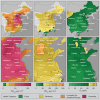Air Pollution in China: Mapping of Concentrations and Sources
- PMID: 26291610
- PMCID: PMC4546277
- DOI: 10.1371/journal.pone.0135749
Air Pollution in China: Mapping of Concentrations and Sources
Abstract
China has recently made available hourly air pollution data from over 1500 sites, including airborne particulate matter (PM), SO2, NO2, and O3. We apply Kriging interpolation to four months of data to derive pollution maps for eastern China. Consistent with prior findings, the greatest pollution occurs in the east, but significant levels are widespread across northern and central China and are not limited to major cities or geologic basins. Sources of pollution are widespread, but are particularly intense in a northeast corridor that extends from near Shanghai to north of Beijing. During our analysis period, 92% of the population of China experienced >120 hours of unhealthy air (US EPA standard), and 38% experienced average concentrations that were unhealthy. China's population-weighted average exposure to PM2.5 was 52 μg/m3. The observed air pollution is calculated to contribute to 1.6 million deaths/year in China [0.7-2.2 million deaths/year at 95% confidence], roughly 17% of all deaths in China.
Conflict of interest statement
Figures





References
-
- World Health Organization. WHO methods and data sources for global causes of death 2000–2012. Global Health Estimates Technical Paper WHO/HIS/HSI/GHE/2014.7. 2014. Available: http://www.who.int/entity/healthinfo/global_burden_disease/GlobalCOD_met....
-
- World Health Organization. Burden of disease from the joint effects of Household and Ambient Air Pollution for 2012. WHO Technical Report. 2012. Available: http://www.who.int/phe/health_topics/outdoorair/databases/AP_jointeffect....
-
- O’Keefe B. Recent Trends in Air Quality Standards in Europe and Asia: What’s next? HEI Annual Conference 2012. 2013. Available: http://www.healtheffects.org/Slides/AnnConf2013/OKeefe-Sun.pdf.
-
- Dockery DW, Pope CA, Xu X, Spengler JD, Ware JH, Fay ME, et al. An association between air pollution and mortality in six U.S. cities. N Engl J Med 1993; 329(24), 1753–1759. - PubMed
Publication types
MeSH terms
Substances
LinkOut - more resources
Full Text Sources
Other Literature Sources
Medical
Research Materials

